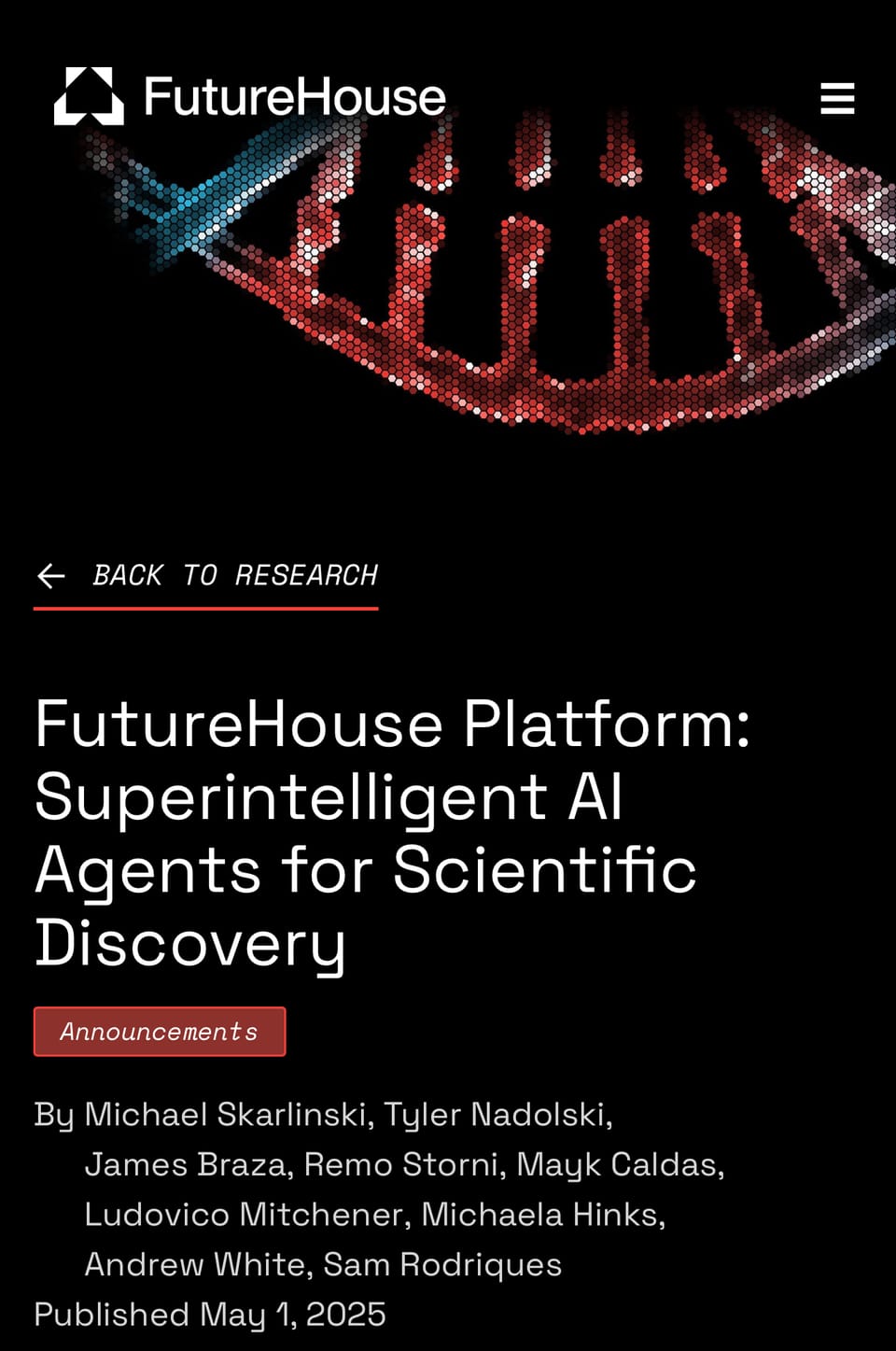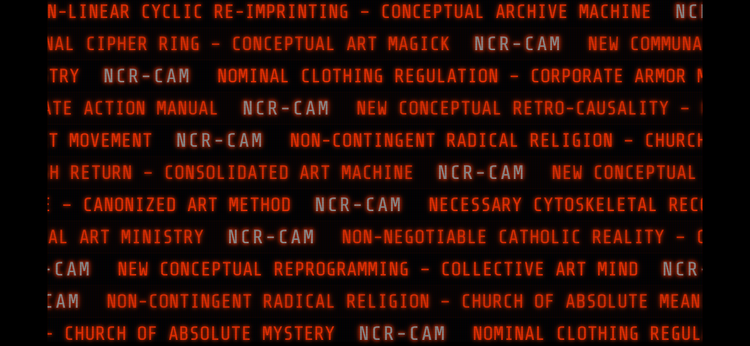Futurehouse - Research Grade AI Chatbots

https://platform.futurehouse.org/trajectories/de034611-b010-4465-821e-7cb07dd22ab7
Abstract—The development of artificial general intelligence (AGI) and the prospect of a technological singularity have been subjects of intense debate over several decades. Early futurists such as Ray Kurzweil famously predicted that an AI passing the Turing test—an approximate proxy for achieving AGI—would appear as early as 2029 and that the singularity, defined as the merging of human and machine intelligence or the point at which machine intelligence vastly exceeds human capabilities, would occur by 2045. However, cutting edge research over the past few years reveals that there is no unified consensus on the precise timeline or even the underlying dynamics of these phenomena. Instead, predictions are marked by wide variability, methodological challenges, and deep epistemic uncertainty. This report synthesizes evidence derived from expert surveys, retrospective analyses, and critical evaluations of forecasting methodologies in order to provide a structured overview of the current state of consensus (or lack thereof) regarding AGI and the singularity.
I. Introduction
The journey toward creating a machine capable of general intelligence that rivals or surpasses human performance has historically captured the imagination of both scientists and futurists. The early optimism of the 1950s and 1960s—when visionaries such as Marvin Minsky and Claude Shannon anticipated that machines would soon replicate human reasoning—has given way to a more measured discussion about the technical, philosophical, and safety challenges inherent in AGI development (1.1). Despite recurring predictions, including Kurzweil’s celebrated timeline (AI passing the Turing test by 2029, the singularity by 2045), cutting edge research indicates that these dates may be more reflective of aspirational scenarios than of thoroughly substantiated forecasts (2.1). In this report, we critically evaluate the range of expert opinions and survey findings, examine the methodological underpinnings of AGI predictions, and discuss the inherent challenges in forecasting transformative AI developments.
II. Historical Perspectives and Early Forecasts
Historically, forecasts for human-level AI and the subsequent emergence of superintelligent systems have oscillated between extreme optimism and deep skepticism. Early futurists projected rapid advances in computing and algorithmic progress that would lead to AGI within a generation (1.1). These predictions were often based on exponential trends such as Moore’s law and assumptions regarding recursive self-improvement. For instance, Kurzweil’s Law of Accelerating Returns supported his 2029 prediction for an AI passing the Turing test, followed closely by a supposed singularity around 2045 (3.1). However, empirical retrospectives reveal that many of these early forecasts were overly optimistic; subsequent decades witnessed several “AI winters,” during which progress in replicating human-level intelligence stalled (4.1).
Moreover, historical predictions frequently lacked the benefit of systematic calibration. Critics have noted that early AI expectations seldom accounted for the emergent complexity of real-world cognitive tasks, for the difficulties inherent in extracting robust learning signals from noisy data, or for the possibility of unforeseen engineering hurdles (4.2). These shortfalls, combined with statistical analyses of prediction databases, illustrate that expert forecasts across time have exhibited wide scattering—often spanning multiple decades—without converging on a narrow and robust range (4.3).
III. Empirical Surveys and Expert Opinions
Recent surveys of AI experts have substantiated the picture of persistent disagreement. In several international surveys, a significant fraction of participants forecast AGI to emerge within the current century, with many estimates clustering around mid-century milestones. For instance, one survey reported median predictions including an optimistic scenario around 2022, a “realistic” forecast around 2040, and a pessimistic outlook pushing to 2075 (1.2). Other surveys indicate that while some experts see a relatively near-term possibility—with nearly 42% believing in emergence by 2030—others remain cautious, expecting AGI only in later decades or even centuries (5.1).
A common thread in these surveys is not only the range of predicted dates but also an underlying divergence in the perception of AI risk and controllability. Experts who view AGI as an extension of current tool-based paradigms tend to forecast longer and more gradual timelines, favoring the notion that existing machine learning approaches can be scaled incrementally over decades (6.1, 6.2). In contrast, proponents of the “intelligence explosion” thesis—who argue that once AGI is achieved further recursive self-improvement will occur almost instantaneously—predict faster transitions to a singularity, although these views are often counterbalanced by concerns over alignment and control issues (7.1).
Furthermore, comparative analyses by Armstrong and Sotala (4.1, 4.3) have demonstrated that expert predictions are statistically indiscernible from non-expert forecasts in aggregate. This observation suggests that formal expertise in AI does not appear to confer markedly improved predictive accuracy regarding AGI timelines. The predictor’s age, individual methodology, and affiliation with specific research communities (industry, academia, or dedicated AI safety groups) also tend to correlate with the temporal forecasts and the degree of concern regarding potential risks (6.3).
IV. Methodological Considerations
Predicting the emergence of AGI is inherently problematic due to the unprecedented nature of the phenomenon. Extrapolations based on past technological trends such as Moore’s law are appealing because of their apparent simplicity, yet they tend to neglect the qualitative shifts in algorithmic design and systemic intricacies that characterize human cognition. Many researchers argue that AGI will not simply be a linear extrapolation of current narrow AI capabilities, but rather a fundamentally different kind of system that may require novel breakthroughs in understanding cognition, embodiment, and self-awareness (8.1).
A key methodological challenge is the reliance on “insight” versus “grind” predictions. “Grind” predictions assume that incremental advances and resource scaling (e.g., larger networks, more data, faster processors) will eventually bridge the gap to AGI, whereas “insight” predictions depend on the occurrence of paradigm-shifting breakthroughs. The latter, by definition, are more difficult to forecast reliably. Consequently, many AI timeline predictions remain grounded in subjective expert opinions that are difficult to empirically validate or refute when the systems in question do not yet exist (4.2).
Other scholars have attempted to model AGI timelines by drawing analogies to biological evolution or by comparing brain processing limits to machine performance. However, such models are often oversimplified and have not been robustly validated by historical data. In particular, attempts to calibrate predictions based on the “brain-scaling” argument tend to face criticism for ignoring qualitative differences between biological and artificial processing and for underestimating the role of unforeseen obstacles in replicating human-like reasoning (9.1, 10.1).
Moreover, studies by Shah and colleagues (11.1, 11.2) have employed Bayesian models and empirical trend analyses to forecast advanced AI timelines. Although these models produce median estimates in the 2040 to 2052 range for transformative AI, they also acknowledge substantial uncertainty, with chances for AGI emerging earlier (by 2030-2036) being relatively low (around 8–15%). Thus, while computational trend-based models provide a form of statistical grounding, they are limited by the inherent variability in the underlying technological drivers.
V. The Divergence between AGI and Singularity Predictions
The question of AGI is distinct from—but closely related to—that of the technological singularity. Many AGI forecasts focus on when machines will exhibit human-level performance across a wide range of tasks. In contrast, singularity predictions additionally incorporate the idea that once AGI is achieved, subsequent recursive self-improvement will lead to a runaway intelligence explosion that quickly outstrips human capacities. This bifurcation in perspectives is clearly evident in the literature. For example, while Kurzweil’s predictions explicitly couple AGI with a rapid singularity occurring almost immediately after human-level intelligence is reached (kurzweil’s view approximated in schneider2504generativetoagentic pages 33-35), other experts view the transition to superintelligence as potentially gradual and distributed, with intelligence amplification occurring over extended periods rather than as an abrupt explosive event (7.2, 7.3).
Some researchers posit that transformative changes, such as human-AI symbiosis or the merging of human cognition with machine augmentation, could lead to a type of “intelligence amplification” that is less dramatic than a singularity per se (7.4). This view emphasizes a continuum of enhancements rather than a sharp discontinuity in cognitive capabilities. Conversely, critics caution that predictions of a “hard take-off”—a rapid transition to superintelligence—are methodologically suspect, cautioning that such forecasts often rely on oversimplified models of recursive self-improvement that neglect the engineering, social, and physical constraints affecting AI development (10.2, 12.1).
VI. Risk, Uncertainty, and the AGI Debate
Parallel to timeline forecasts, considerable debate surrounds the risks accompanying AGI and the singularity. Surveys indicate that approximately 77% of experts agree that AI safety research is highly important, though divergent opinions exist regarding the probability of catastrophic outcomes (6.2, 5.2). Some researchers adopt a precautionary stance, arguing that even if AGI emerges later than some forecasts suggest, the potential for irreversible risks demands a proactive approach to safety design and regulatory oversight. Others remain skeptical that advanced AI will ever reach a point where it poses an existential threat, emphasizing the controllability of tool-like systems and the gradual nature of technological progress (13.1, 13.2).
The divergence in risk assessment is closely tied to the underlying timeline predictions. Advocates of early AGI emergence frequently stress the need for immediate, robust safety mechanisms, while more cautious estimates lead to a belief that gradual progress will allow ample adaptation by societal and regulatory structures (14.1, 5.3). Additionally, a significant portion of the research community contends that expert familiarity with core AI safety concepts—such as the “off button” problem, instrumental convergence, and scalable oversight—is unevenly distributed, which in turn influences individual assessments regarding both timelines and existential risk (6.3).
VII. Synthesis of the Consensus in Cutting Edge Research
The body of cutting edge research and expert surveys reveals several key points that can be synthesized as follows:
1. No Unified Timeline:
There is no universally accepted timeline for the emergence of AGI or the technological singularity. Expert predictions vary widely, with estimates for AGI spanning from near-term breakthroughs in the 2020s and 2030s to more conservative forecasts placing key milestones in the mid- to late-21st century or even beyond (1.2, 4.3, 7.5). This variability underscores a fundamental epistemic challenge in forecasting technologies that have no historical analogue (10.3).
2. Divergence between AGI and Singularity Predictions:
While many surveys and studies focus on the attainment of AGI defined as human-level ability across diverse tasks, the subsequent transition to a technological singularity remains even more contentious. Proponents of a rapid, hard take-off argue that recursive self-improvement could compress the timeline between AGI and superintelligence to mere years or even months (7.1). Conversely, other evidence suggests that improvements may continue gradually, moderated by engineering constraints, diminishing returns, and sociotechnical feedback loops (7.6, 10.1).
3. Varied Methodologies Yielding Similar Disagreement:
Analysis of prediction methodologies reveals that both “grind” approaches—rooted in incremental improvements and scaling of hardware—and “insight” approaches—dependent on breakthroughs in understanding intelligence—yield a similar spread of forecasts. Studies by Armstrong and Sotala have shown that expert and non-expert timeline predictions are statistically indistinguishable, highlighting the inherent difficulty in forecasting unprecedented technological transitions (4.1, 4.3).
4. The Role of Uncertainty and Subjectivity:
The consensus among cutting edge researchers is less about a specific predicted date and more about a recognition of the deep uncertainty that surrounds the field. Complexities in modeling adaptive, knowledge-driven systems, along with the unpredictable nature of breakthrough innovations, mean that forecasts are best understood as ranges or probabilities rather than as fixed milestones (7.7, 10.4). In this regard, even when median forecasts center around mid-century, the error margins are substantial.
5. Risk Mitigation and the Imperative of Safety Research:
Regardless of the exact timeline, there is broad agreement that preparing for the potential transformational impacts of AGI—whether through proactive safety research, robust regulatory frameworks, or public governance—is essential. A considerable fraction of experts emphasize the importance of addressing alignment and controllability issues early in the research process to mitigate the risks posed by advanced systems (6.2, 5.2).
6. The Influence of Conceptual and Philosophical Debates:
Philosophical critiques continue to shape the discourse, with prominent figures questioning whether the metrics currently used to forecast human-level intelligence truly capture the essence of cognition. This includes debates over whether AGI, once achieved, would be analogous to human intelligence or represent something entirely qualitatively different that might defy conventional measurement (9.2, 8.2).
VIII. Discussion
The synthesis of cutting edge research presents a complex, multi-dimensional picture. On one hand, surveys of AI experts, driven by estimates grounded in large-scale computational models and historical trend analysis, commonly converge on median dates in the mid-21st century for AGI. On the other hand, significant dissent and subjective uncertainty dominate the literature, with systematic reviews revealing that even experts with decades of experience hold predictions that are as much reflective of personal belief systems and methodological preferences as they are of rigorous quantitative modeling (1.1, 4.4).
Moreover, while individual studies sometimes suggest a clustering around milestones such as 2030, 2040, or 2075, these results are not robust enough to constitute a consensus in the strictest sense. Instead, the state of the art in AGI forecasting is characterized by a wide range of outcomes, each contingent on numerous assumptions regarding how current narrow AI approaches will generalize and how breakthrough insights might complement or even disrupt incremental progress (7.8, 7.9).
The debate over whether the transition to superintelligence will involve a sudden “hard take-off” or a more gradual “soft take-off” further complicates the picture. Although some academics and industry leaders have expressed concerns that recursive self-improvement could lead to an intelligence explosion that outpaces human mitigation efforts almost overnight (7.10, 3.1), others argue that empirical evidence does not support such an abrupt shift (10.2, 12.1).
Adding to the challenge is the observation that predictions made by experts do not consistently improve over time nor do they seem systematically calibrated relative to historical benchmarks. As demonstrated in several analyses, subjective bias, overconfidence, and the limitations inherent in forecasting unprecedented scientific breakthroughs have contributed to a persistent dispersion in predicted timelines (4.1, 6.3).
Furthermore, while technological progress in terms of computational speed and data availability continues unabated, fundamental technological challenges—such as understanding the true nature of human cognition, developing cognitive architectures that replicate the intricacies of consciousness and self-awareness, and safely aligning a potentially superintelligent system with human values—remain largely unsolved (7.5, 2.2). These challenges imply that any simplistic extrapolation from current narrow AI performance to fully functional general intelligence is likely to be overly reductive.
IX. Implications for Research and Policy
Given the absence of consensus on precise timelines, a prudent approach for both researchers and policy makers is to plan for a range of potential futures rather than to fixate on a single forecast date. This entails investing in robust AI safety research, establishing flexible regulatory frameworks capable of adapting to a rapidly evolving technological landscape, and fostering interdisciplinary dialogue among computer scientists, ethicists, and policy experts (6.4, 13.1).
Policy initiatives should emphasize early intervention and proactive planning in order to mitigate potential risks without stifling innovation. Even if the achievement of AGI and the technological singularity occurs later than the most optimistic forecasts suggest, the sheer scale of transformation in areas such as economic systems, military strategy, and social organization necessitates that preparatory work begins now (14.1, 5.2).
This is particularly important because the research literature indicates that the risk is not solely a function of when AGI is achieved, but also of how the transition is managed. A gradual, observable progression offers opportunities for human oversight and adjustment, whereas a sudden, unexpected take-off may leave little time for corrective intervention (7.3, 10.5).
X. Limitations of Current Forecasting Approaches
A critical aspect of the ongoing debate is the acknowledgment that forecasting AGI and singularity events involves intrinsic limitations in predictive power. The complexity of the tasks involved in replicating human cognition in machines, combined with the non-linear nature of technological breakthroughs, implies that any forecast must be regarded as provisional and laden with considerable uncertainty (4.3, 10.2).
Several scholars have argued that current prediction models suffer from fundamental problems such as selection bias, overfitting to past trends, and a failure to account for black swan events—unpredictable breakthroughs or obstacles that dramatically alter the trajectory of AI research (9.1, 13.2). These limitations imply that even if median estimates for AGI and singularity are used as reference points, they should be interpreted with caution because of the large margins of error inherent in such models.
Moreover, the fact that expert predictions by seasoned AI researchers are not significantly more accurate than those by non-experts further undermines the reliability of forecasted timelines. This observation strongly suggests that until a new paradigm or breakthrough in AI theory is achieved, forecasting will remain a speculative endeavor rather than a predictive science (4.4, 6.3).
XI. Conclusions
Synthesizing the available evidence from cutting edge research and expert surveys, it can be concluded that there is no definitive consensus on the precise timeline for the emergence of AGI or the occurrence of a technological singularity. Although early futurists such as Ray Kurzweil provided concrete dates (e.g., 2029 for an AI passing the Turing test and 2045 for the singularity), the contemporary literature shows that expert predictions remain highly variable, with forecasts ranging from near-term breakthroughs in the early 2030s to more conservative estimates as late as the 2070s or beyond (1.2, 7.5).
The current state of cutting edge research emphasizes several key points: first, that AGI may emerge gradually rather than via a sudden "hard take-off" as envisioned by some futurists; second, that there is significant methodological uncertainty, with prediction models yielding wide error margins due to the unprecedented and complex nature of the task; and third, that regardless of the timeline, the potential societal, ethical, and existential ramifications of AGI and superintelligence necessitate a proactive approach to AI safety research and governance (6.1, 5.1).
Overall, while many forecasts converge on the notion that transformative AI developments are likely to occur within this century, no robust, unified consensus exists regarding the precise dates or the precise nature of the transition from narrow AI to AGI and ultimately to the technological singularity (7.6, 10.4). Instead, the emphasis among researchers is on acknowledging and preparing for uncertainty—a recognition that the true path to AGI may ultimately be governed by factors that elude simple extrapolation from current trends (11.1, 13.1).
In summary, while early predictions like those by Kurzweil have driven much public discussion, the consensus in cutting edge research is that predictions of AGI and the singularity must be treated as probabilistic ranges rather than fixed milestones. The variability among expert forecasts, the divergence between “insight” and “grind” methodologies, and the persistent epistemic challenges all point to a future where precise timelines remain an open question—one that will require continued interdisciplinary research, methodological refinement, and the prudent implementation of risk-mitigation strategies (7.11, 6.4, 10.1).
By taking into account the spectrum of expert opinions and adopting a policy of caution informed by the inherent uncertainties, both the research community and policy-makers can ensure that the transformative potential of AGI is harnessed responsibly, even as robust, evidence-based forecasting remains an elusive goal (gao2019artificiallyintelligentcopyright pages 21-24, 14.1).
This report thereby concludes that, despite decades of anticipation and numerous high-profile predictions, the current consensus among cutting edge research is not that a singular date for AGI or the singularity is imminent, but that a wide range of timelines remains plausible. Given this state of affairs, efforts should be directed not solely at forecasting precise dates but at preparing for a variety of scenarios—embracing the technical, ethical, and societal dimensions that will inevitably accompany any future breakthrough in AGI (7.12, 9.1, 13.2).
References to extensive critical analysis further highlight that the debate is not merely about when AGI will emerge but also about how such a transition should be managed. The potential for an intelligence explosion or a series of gradual, disruptive innovations means that future policy responses must remain adaptive, informed by ongoing research, and commensurate with the scale—and unpredictability—of the technological evolution anticipated (10.5, 12.1).
In conclusion, while early forecasts provided concrete dates, contemporary cutting edge research underscores a landscape characterized by significant dissent and extensive uncertainty. The absence of a singular, unified consensus mandates that both scientists and policy-makers adopt flexible strategies capable of addressing multiple potential outcomes in the journey toward AGI and the associated technological singularity. This recognition of uncertainty and the corresponding need for adaptive risk management represent the current state of consensus in the field—a consensus that is as much about embracing the unknown as it is about preparing for the transformative implications of advanced AI.
1
Everything Is Obvious
Ryan B. AbbottThe Reasonable Robot, Oct2017citations 202Contexts:Used 1.11.2
2
Artificially Intelligent Copyright: Rethinking Copyright Boundaries
AH Gaon 2019citations 7Contexts:Used 2.12.2Unused 2.3
3
Generative to Agentic AI: Survey, Conceptualization, and Challenges
J SchneiderArXiv, 2504Contexts:Used 3.1Unused 3.2
4
How We’re Predicting AI – or Failing to
Stuart Armstrong, Kaj SotalaTopics in Intelligent Engineering and Informatics, Jan 2015citations 149Contexts:Used 4.14.24.34.4
5
Exploring Posthuman Conundrums and Policy Recommendations for Fostering Peaceful Co-Existence With Sapio-Sentient Intelligences
NA Ravindran 2018Contexts:Used 5.15.25.3Unused 5.45.5
6
Why do Experts Disagree on Existential Risk and P(doom)? A Survey of AI Experts
Severin FieldArXiv, Jan 2025citations 1Contexts:Used 6.16.26.36.4
7
More Bit than Bio-communicating and discussing Whole Brain Emulation, Mind Uploading & Superintellingence using thought experiments
FL Ribeiro 2021Contexts:Used 7.17.27.37.47.57.67.77.87.97.107.117.12Unused 7.137.147.157.167.177.187.19
8
Computational Creativity in Media Production: At the Crossroad of Progress and Peril
D Keller 2023citations 1Contexts:Used 8.18.2
9
Understanding machine learning–a philosophical inquiry of its technical lineage and speculative future
FTH Lo 2024Contexts:Used 9.19.2
10
A Criticism of the Technological Singularity
Alexander K. SeewaldLecture Notes in Networks and Systems, Jan 2022
PEER REVIEWED
citations 3Contexts:Used 10.110.210.310.410.5
11
An approach to technical agi safety and security
R Shah, A Wang, A ConmyArXiv, 2025citations 2Contexts:Used 11.111.2Unused 11.311.411.511.611.711.8
12
On controllability of artificial intelligence
R Yampolskiy 2016citations 34Contexts:Used 12.1Unused 12.2
13
From Machine Learning to Artificial General Intelligence: A Roadmap and Implications
Omar Ibrahim ObaidMesopotamian Journal of Big Data, Aug 2023citations 37Contexts:Used 13.113.2Unused 13.313.413.513.6
14
Journey of Artificial Intelligence Frontier: A Comprehensive Overview
Saphalya PetaGlobal Journal of Computer Science and Technology, Sept 2023citations 10Contexts:Used 14.1Unused 14.2
Keywords—Artificial General Intelligence, Technological Singularity, AGI forecasting, intelligence explosion, expert surveys, predictive uncertainty, AI safety, recursive self-improvement.






Member discussion